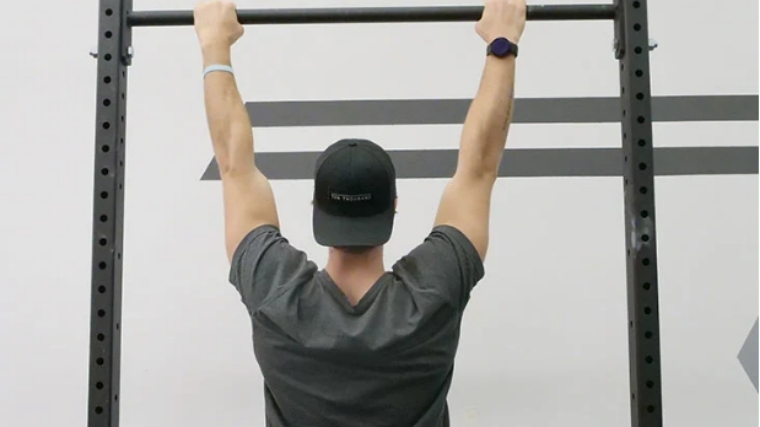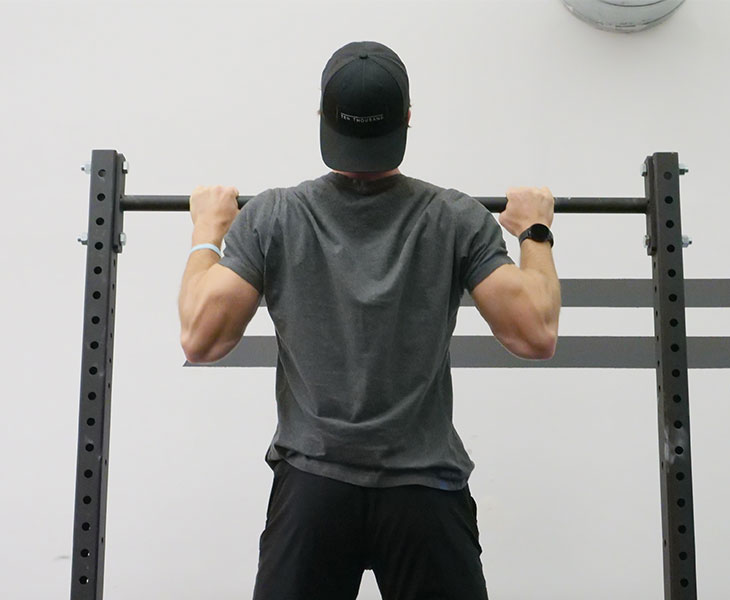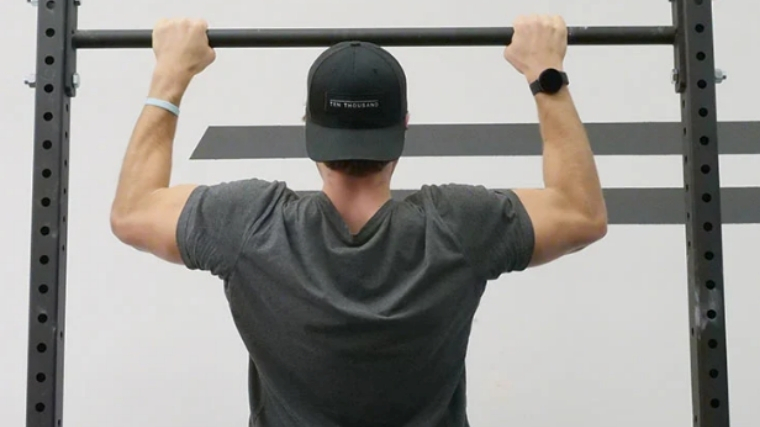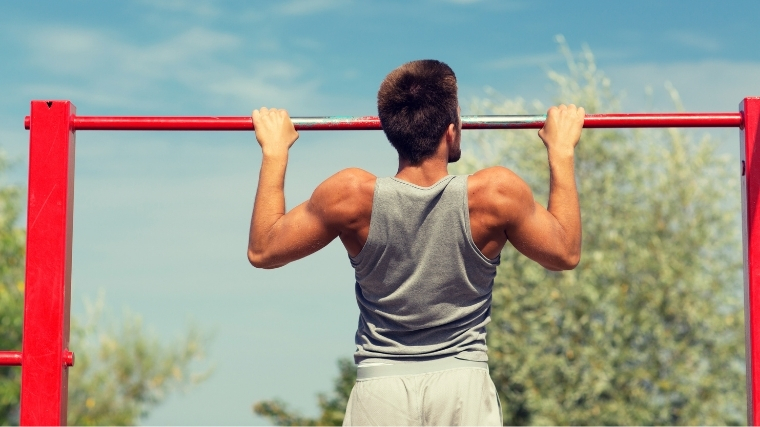The pull-up is a foundational upper body exercise that carries many benefits — namely more back and arm muscle, pulling strength, and full-body control. It’s also straightforward to do. Whether you belong to a big box gym or have your own home gym, you just need a pull-up bar. From there, you pull yourself up until the chin passes the bar. Easy, right? Well, not so fast.
Though the exercise is simple in execution, it takes a lot of practice to nail your first pull-up. Below, we’ll go building more upper body strength over how to do your first pull-up, in addition to the move’s benefits, variations, alternatives, and programming recommendations.
- How to Do the Pull-Up
- Pull-Up Sets and Reps
- Common Pull-Up Mistakes
- Pull-Up Variations
- Pull-Up Alternatives
- Muscles Worked by the Pull-Up
- Benefits of the Pull-Up
- Who Should Do the Pull-Up
- Frequently Asked Questions
Editor’s note: The content on BarBend is meant to be informative in nature, but it shouldn’t take the place of advice and/or supervision from a medical professional. The opinions and articles on this site are not intended for use as diagnosis, prevention, and/or treatment of health problems. Speak with your physician if you have any concerns.
Pull-Up Video Guide
Check out BarBend‘s video tutorial on how to master the pull-up.
How to Do the Pull-Up
While there are many ways to perform pull-ups, the following is a step-by-step guide for performing a strict bodyweight pull-up.
Step 1 — Establish Your Grip

Start by assuming a pronated grip (palms facing away from you) on a bar with your hands slightly wider than shoulder-width apart. Be sure to hang at the bottom of the pull-up freely. You should be able to have your head in between your biceps with your elbows fully extended.
Form Tip: Brace your core so that your entire body is set for the pull.
Step 2 — Set Your Back

Once you’ve set your grip, pull your shoulders down slightly to create a firm foundation to begin your pull-up. This retraction of your scapula will be very subtle and will “open” your chest slightly when done correctly.
Form Tip: As you’re warming up — or if this is the sticking point in your pull-up — spend some time here doing scapular pulls. Beging the pulling motion with your shoulder blades, but you stop and go back down before you start bending your elbows.
Step 3 — Drive Your Elbows to the Floor

Once set, think about pulling the bar to your chest so that your elbows drive into your back pockets. You can also think about driving your elbows through the floor as you pull yourself upwards. Keep pulling until your chin is over the bar.
Form Tip: Avoid yanking with your arms. Instead, focus on using your lats to drive the movement.
Step 4 — Stabilize and Descend

Once you have arrived at the top of the bar, stabilize your body and then lower yourself to the start position under control.
Form Tip: Be sure to keep tension on your back and between your shoulder blades throughout the movement. Always secure a stable core and shoulder girdle before proceeding into another repetition.
Pull-Up Sets and Reps
- For Muscle Mass: Do 4 sets of 10 reps. Leave 1-2 reps in the tank for each set.
- For Strength: Perform 5 sets of 5 weighted reps.
- For Endurance: Use every minute, on the minute (EMOM) training here. At the top of each minute, perform five to 10 reps. Set a timer for 10 minutes and repeat until time runs out.
Common Pull-Up Mistakes
Whether someone is just learning pull-ups or are getting a little too confident in their skills, there are some common issues many lifters run into with pull-ups. Learn these mistakes ahead of time to make sure you avoid them.
Unintentional Kipping
If you want to perform kipping pull-ups once you’ve developed plenty of strict pull-up strength, have at it. But if you’re not intended to kip your pull-up, you might just be cheating your form unintentionally by rocking your body up toward the bar. While a little bit of body English can be helpful in certain circumstances, you’ll only be cheating yourself out of gains if you kip all of your reps without meaning to.
Avoiding Full Extension
To crank out a few more reps, many lifters might avoid performing pull-ups with a full range of motion. If you’re intentionally avoiding full extension at the bottom of your reps to take it easy on your shoulders, it’s best to listen to your body and modify your moves as needed.
But if you’ve got full clearance to go deep into a full pull-up by letting your arms fully extend at the bottom of each rep, actually doing so will let you get the most out of your reps.
[RELATED: Best Mobility Exercises]
Yanking With Your Arms
Tugging upward with your arms instead of initiating the pull with your lats can be difficult for lifters at all levels. To help avoid the inefficient yank, brace your core at the bottom of each rep and focus on pulling your elbows into your back pockets. Alternatively, think of driving your elbows to the ground instead of tugging your body up.
Pull-Up Variations
After you’ve conquered the strict pull-up, you can begin to add variations based on your training goal. You can use a range of pull-up variations to increase specific adaptations instead of haphazardly programming them.
Pull-Up Pauses and Holds
If you’ve got strict pull-ups down and want to add some more challenges to your pull-up routine, try using pauses and holds throughout various ranges of motion. Basically, instead of just lowering yourself slowly, you’ll add in full pauses at certain points to increase time under tension and the time you spend holding your own bodyweight at different angles.
When using pauses in pull-ups, some great starting places are at the top of the movement (when a full contraction is needed) and at the midway point (when your elbows are at about 90 degrees). Ensure you are thoroughly warmed up for this and pay attention to any sharp pains in your elbows. That kind of pain is a signal to abort the mission and take it easier on your upper body joints.
Chest-to-Bar Pull-Up
The chest-to-bar pull-up is a pull-up variation that can be done strictly, with weight, or through kipping. This variation is a step up from regular pull-ups and eccentrics because it forces your to pull yourself higher into the pull-up. You’ll getting your chest to the bar rather than just your chin over the bar.
To perform a chest-to-bar pull-up, you’ll follow the same protocols that you would for a strict or kipping pull-up. However, instead of finishing with your chin clearing the bar, you’ll follow through even further to bring your chest to the bar.
Weighted Pull-Up
If you’re looking to maximize strength and hypertrophy, weighted pull-ups are the way to go. This lift is a typical go-to variation for athletes trying to progress their pull-up intensity using an external load. This variation is endless and only capped by your ability to execute great reps at various amounts of weight.
To execute a perfect weighted pull-up, strap yourself into a dip belt (not just for dips!). Then, loop in a weight plate of your choice. Proceed as normal with your pull-up. Just make sure your form remains rock solid the whole time.
Kipping Pull-Up
Amongst CrossFitters and gymnastic sports folk, the kipping pull-up is often a go-to. This pull-up style is ballistic in nature. It utilizes momentum from a kipping motion to increase your inertia to pull yourself to the bar.
To perform a kipping pull-up, use your body’s momentum to create a slight forward swing from the bar. On the back end of the swing, channel that momentum into bringing yourself up to complete the pull-up. Although this might sound like an easier variation, the overall muscle damage and demand on your shoulders — in compromising positions — is greater than in a strict pull-up, so the risk of injury is often higher.
Pull-Up Alternatives
Not quite at pull-up level yet? No problem. There are plenty of alternatives to pull-ups that can help build some serious back strength and help you give you the form and strength you’ll need to work up to your first ever pull-up.
Dumbbell Row
The dumbbell row is a fantastic upper body unilateral pulling exercise that can serve as a great foundation builder for those on the quest of building more upper body strength. When hypertrophy and strength are your goals, then the dumbbell row can be a beneficial exercise to add additional pulling volume.
[Read More: The Best Upper Body Exercises and Workouts]
Perform the dumbbell row unsupported or with your knee supported on a flat bench, with a similar movement pattern to a bent-over barbell row. In this case, your hand will have a neutral grip on the dumbbell instead of an overhand or underhand grip. Don’t jerk your hips and torso to the opposite side to kip the weight up. Instead, focus on putting your working elbow into your back pocket and lowering the weight again slowly. Keep your back roughly parallel to the ground the whole time.
Inverted Row
The inverted row is basically a horizontal pull-up. It’s often used to help folks who can’t yet do a pull-up get acclimated to manipulating their bodyweight while pulling. While these exercises both incorporate back, biceps, and grip training, the inverted row and the pull-up angles are different. You’re pulling yourself vertically with a pull-up and horizontally with an inverted row. Athletes should strive to build strength using inverted rows and assisted pull-ups and then progress into full pull-ups.
To perform an inverted row, use a stable bar — a Smith machine in a locked position will do nicely — and grasp the bar roughly shoulder-width apart. Allow yourself to limbo slightly underneath it, adjusting your feet to make yourself as horizontal as you feel comfortable with. As with a push-up, keep your core tight, and your glutes squeezed to maintain a solid midline. Pull yourself up toward the bar by initiating the pull with your shoulder blades, much like you would with a bent-over row. If being horizontal is tough for you, that’s okay — stand a little straighter at first, and get lower to the ground as you get stronger and more used to the movement.
Lat Pulldown
Lat pulldowns are a machine-based exercise that targets the same muscle groups used in the pull-up. Using the lat pulldown machine can help isolate the latissimus dorsi muscles, overload your back with extra volume, and even increase your strength when you may lack what you need to perform a full pull-up.
To perform proper lat pulldowns, make sure you’re initiating the movement the same way you would with a pull-up. Engage your back instead of yanking down and away from the bar. To make it feel a little more like a pull-up in core engagement, perform lat pulldowns while in a tall kneeling position instead of a seated position.
Pulldowns are not a replacement for pull-ups, but are a good accessory to help you increase back strength and start greasing the groove of your pull-up form.
Dead Hang
When you can’t yet do a pull-up but you want to get your body used to hanging from the bar, try some dead hangs. Get into the initial pull-up position and engage your shoulder blades like you’re preparing to perform an actual pull-up.
Instead, you’ll just maintain a strong grip on the bar with your elbows straight. Concentrate on the activation in your upper back, and make sure you’re breathing. Stay up there with good form for as long as you can and record your time to track your progress.
Eccentric Pull-Up
One of the best ways to acclimate yourself to pull-ups is by performing pull-up eccentrics. In the pull-up, the eccentric is the lowering portion of the movement. For pull-up eccentrics, the goal is to lower your body with a time-oriented goal. The longer the lowering process, the tougher the movement.
To integrate these into your program, find a box or bench and use it to stand on so you can jump to the top of the pull-up bar. Once your chin is clear of the bar, begin to lower yourself slowly with a time-based goal you’ve set for yourself. At first, it might be to just move with enough control to avoid flopping back down. Then you might build to two seconds, then three, then seven, etc.
Banded Pull-Up
Banded pull-ups are excellent tools to help get you where you need to be. Essentially, you’ll be securing a band underneath your foot to help offset some of your body weight to assist you in performing your pull-up.
Loop a long, sturdy resistance band securely around a pull-up bar so that it’s dangling in front of you. Step one foot into the loop and grab onto the pull-up bar. Take a moment to get your balance, adjusting your non-banded leg as needed to keep your midline centered. Perform a strict pull-up as outlined above.
Muscles Worked by the Pull-Up
Pull-ups are often a staple in upper body workouts because of their ability to target multiple muscles at once. Here’s a breakdown of the muscles worked by the pull-up.
Latissimus Dorsi
This one might seem a little obvious, but your lats are the major mover with the pull-up — hence the reason the lift is often thought of as a huge contributor to a V-shaped musculature. Keep the lats in mind with each rep, because it’s tempting to just yank with your biceps instead of using the discipline you need to raise and lower yourself with your lats.
Biceps Brachii
Even though you shouldn’t be primarily pulling through your biceps, they’ll get torched by a solid pull-up session. If you’re looking to really put your biceps to work, switch your grip to a chin-up.
Infraspinatus
Part of your rotator cuff, the infraspinatus helps stabilize your shoulder joints. It also helps you elevate and depress your shoulders, which is definitely a huge part of the pull-up.
Lower Trapezius
Your lower traps help you pull your shoulders back and down. Stronger traps translate into stronger lifts and less frequent injuries, so this isn’t a muscle area to be discounted.
Erector Spinae
The erector spinae consists of a group of muscles and tendons running on your back from the base of your skull down to your hips. During a pull-up, these are what will help you maintain proper body positioning and posture.
External Oblique
Throughout the entire pull-up, you’ll be steadying yourself against core rotation. Enter your external obliques, which help keep your body stable and from twisting or collapsing.
Benefits of the Pull-Up
The pull-up comes packed with many benefits, and when they’re performed regularly, these benefits only increase. Below are a few of the most notable pull-up benefits.
A Bigger, Stronger Back
The pull-up is an effective exercise to increase your back strength and muscles. Pull-ups can also improve the width of your back muscles, which you might be looking for if you want to take a bodybuilder’s approach to back training.

[Read More: The Best Bodyweight Exercises, + Workouts and Tips From a CPT]
Because you can so easily scale and progress pull-ups according to your skill and experience level, the back strength and muscle gains won’t taper off once you’ve mastered the move. With plenty of pull-up alternatives and variations available, the move can help spur back growth no matter your training level.
Carryover to Other Lifts
The back muscles trained by pull-ups can play a large role in carryover to improvements across other lifts. For example, building stronger lats and traps using pull-ups can have indirect carryover to squats and deadlifts, as these muscles are crucial for their success.
Increased Full-Body Coordination
To complete a proper pull-up, your entire body will have to work together — literally from your fingers to your toes. You’re not simply pulling with your arms and calling it a day. Instead, you’re keeping your core braced and your lower body stable so that you’re not wiggling around while you’re executing the lift.
Better Grip Strength
Your hands and forearms are what connect your body to the pull-up bar, and so you’ll need and build a strong grip. Being able to hold and stabilize your entire body weight through multiple sets of work will get your hands and forearms accustomed to handling intense loads — without giving your body all the additional strain that, say, heavy deadlifts would give you.
Who Should Do the Pull-Up
The short answer? Any strength athlete who has access to safe overhead movement and wants to create some serious upper body strength should probably be doing pull-ups.
There are also sports-specific and day-to-day reasons you might want to start thinking about integrating pull-ups into your routine if they’re not already there.
Strength and Power Athletes
All strength and power athletes are typically interested in similar things: building serious upper body strength, increasing midline stability, improving grip strength, and enhancing overhead stability.
- Powerlifters: While powerlifters don’t compete with overhead lifts, more powerful lats translate into a more stable shelf for the back squat, more off-the-floor strength for the deadlift, and a stronger push off the chest for the bench press.
- Weightlifters: Overhead strength and stability are immensely important to weightlifters, which is exactly what pull-ups will give you.
- Bodybuilders: In addition to increasing overall strength, pull-ups can create that oft-desired V-shaped taper by targeting a lifter’s lats.
Functional Fitness Athletes
CrossFitters often incorporate various versions of pull-ups (usually involving kipping) into WODs. That said, even if CrossFit isn’t your thing, there’s almost no move that’s more functional than being able to pull and manipulate your own bodyweight.
General Population
Even if you need to modify a pull-up to start, it can feel pretty empowering to hold your entire body weight from a bar. That sense of accomplishment — and the serious physical gains it will come with — can be a serious source of inspiration for sporadic gymgoers and seasoned athletes alike.
Get Pulling
For a lot of lifters, adding pull-ups to their repertoire is a big aspiration. Once you’ve worked up to include them in your program, this lift will maximize your upper body strength and full-body stability. Even if you can’t yet do a pull-up, use your knowledge of pull-up form to improve your general pulling prowess while you work up to your first unassisted rep.
FAQs
It might be an ideal staple of many training programs, but that doesn’t mean the pull-up doesn’t have an air of mystery about it. Get your most burning pull-up questions answered here.
Can beginners do pull-ups?
Yes, absolutely. Beginners can certainly do pull-ups and should start learning the skill early on. More than likely, you’ll need to start with some pull-up alternatives like inverted rows. Even if you’re an experienced lifter, if pull-ups have never been part of your repertoire, you might find yourself a beginner at pull-ups — and that’s okay. Take your time and focus on good form (and all the other lifts you can crush with ease). On the other hand, if you’ve never tried pull-ups and can hop up and get right into them with excellent form — brava. Dive into some of pull-up progressions like weighted versions.
What muscles do pull-ups work?
Pull-ups work multiple muscles and are fantastic for building a strong upper body. Some of the major prime mover muscle groups pull-ups work include:
- Lats
A few secondary muscles the pull-up targets include:
- Biceps
- Obliques
- Serratus anterior
- Rhomboids
What’s the difference between a pull-up and a chin-up?
Think of chin-ups versus pull-ups as underhand grip (chin-ups) versus overhand grip (pull-ups). While every lifter is bound to have a lot of feelings about the pros and cons of each, the mechanics come down to this: pull-ups are performed with an overhand grip and place more emphasis on the lats, while chin-ups place more emphasis on the biceps and pectoralis major with their underhand (or sometimes neutral) grip. However, this does not mean that chin-ups don’t engage the lats as the primary mover (they do) or that the pull-up doesn’t seriously recruit the biceps (it does).
Is it cheating to kip my pull-up?
Pull-up purists will have one answer, and CrossFitters will have another. While you may not consider it cheating to kip your pull-up, it does offer a lot more mechanical stress — and therefore pose a bigger injury risk — than strict pull-ups. While no two lifters are going to have the same opinion, a good rule of thumb is that you should look at kipping as a skill in and of itself — and you probably shouldn’t tackle that skill until you’ve fully mastered the strict pull-up. On the other hand, if you’re trying to kip to “achieve” your first pull-up, you probably want to back it up and build to a strict pull-up.
What muscles do pull-ups work?
Pull-ups work multiple muscles and are fantastic for building a strong upper body. While your lats are the primary movers for pull-ups, your biceps, serratus anterior, rhomboids, infraspinatus, erector spinae, and obliques will also all get to join in on the fun.
How can I do more pull-ups?
To perform more pull-ups, you need to practice pull-ups. Think of pull-ups like a skill and not just an exercise. A great place to start is to practice pull-ups two to three times a week with variations and progressions to increase your strength and work capacity for this movement.
Featured Image: Microgen / Shutterstock